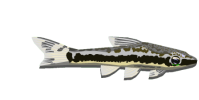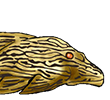Cephalosilurus info
Cephalosilurus info
I visited a local store today and was looking at what they had labelled as a Oremon Catfish. C. fowleri was what turned up for this common name, but from looking at the cat-e-log they might be C. apurensis.
There were 2 of them somewhere in the 6-8" (approx. 150-200mm) range sharing a cave together. Couldn't get an accurate size as one only had it's head showing, and the other just the body. They have had these two fish for a couple of months, have always housed them together. The only incidents they mentioned was that they ate some parrot fish they were previously housed with. They were currently housed with an ornate bichir, some red hook silver dollars, and a golden belly shark. The tankmates were slightly larger than the catfish. The only tankmate that seemed to be in rough shape was the golden belly shark which was a trade in. While watching the cats they didn't even pay attention to their tankmates.
From what I have been reading they are not supposed to get along with each other.
Any ideas why these two are fine with each other? Is this likely to last? Also would they be likely to attack doradid catfish that are larger then themselves?
There were 2 of them somewhere in the 6-8" (approx. 150-200mm) range sharing a cave together. Couldn't get an accurate size as one only had it's head showing, and the other just the body. They have had these two fish for a couple of months, have always housed them together. The only incidents they mentioned was that they ate some parrot fish they were previously housed with. They were currently housed with an ornate bichir, some red hook silver dollars, and a golden belly shark. The tankmates were slightly larger than the catfish. The only tankmate that seemed to be in rough shape was the golden belly shark which was a trade in. While watching the cats they didn't even pay attention to their tankmates.
From what I have been reading they are not supposed to get along with each other.
Any ideas why these two are fine with each other? Is this likely to last? Also would they be likely to attack doradid catfish that are larger then themselves?
- Richard B
- Posts: 6952
- Joined: 11 Aug 2006, 13:19
- I've donated: $20.00!
- My articles: 9
- My images: 11
- My cats species list: 37 (i:0, k:0)
- My aquaria list: 4 (i:0)
- My BLogs: 2 (i:0, p:29)
- Spotted: 10
- Location 1: on the sofa, or maybe at work?
- Location 2: Warwickshire: UK
- Interests: Tanganyika Catfish, African catfish, Non-loricariid sucker-catfish.
Running, drinking, eating, sci-fi, stapelids
Re: Cephalosilurus info
Large doradids are one of the few tankmates i'd recomend.
These are still smallcompared to how big they could get & aggresssion between the individuals might well increase as they grow or if they were moved to a smaller tank.
The dollars are a very quick fish so may well be escaping any attacks but ultimately they are just a snack in waiting - a full grown individual would certainly eat a silver dollar.
What species is a golden belly shark?
These are still smallcompared to how big they could get & aggresssion between the individuals might well increase as they grow or if they were moved to a smaller tank.
The dollars are a very quick fish so may well be escaping any attacks but ultimately they are just a snack in waiting - a full grown individual would certainly eat a silver dollar.
What species is a golden belly shark?
Lou: Every young man's fantasy is to have a three-way.
Jacob: Yeah not with another fu**!ng guy!
Lou: It's still a three-way!
Hot Tub Time Machine: 2010
Jacob: Yeah not with another fu**!ng guy!
Lou: It's still a three-way!
Hot Tub Time Machine: 2010
- Shane
- Expert
- Posts: 4648
- Joined: 30 Dec 2002, 22:12
- My articles: 69
- My images: 162
- My catfish: 75
- My cats species list: 4 (i:75, k:0)
- My aquaria list: 4 (i:4)
- Spotted: 99
- Location 1: Tysons
- Location 2: Virginia
- Contact:
Re: Cephalosilurus info
Eventually they will try to eat anything they are kept with. They will even kill themselves trying. I have seen pseudopims try to take fish twice their own size and then choke to death on their own prey.Also would they be likely to attack doradid catfish that are larger then themselves?
-Shane
"My journey is at an end and the tale is told. The reader who has followed so faithfully and so far, they have the right to ask, what do I bring back? It can be summed up in three words. Concentrate upon Uganda."
Winston Churchill, My African Journey
Winston Churchill, My African Journey
-
Viktor Jarikov
- Posts: 5613
- Joined: 26 Jan 2010, 20:11
- My images: 11
- My cats species list: 25 (i:0, k:0)
- Spotted: 4
- Location 1: Naples, FL
- Location 2: USA
Re: Cephalosilurus info
http://www.planetcatfish.com/forum/view ... alosilurus
I had three of them between 1' and 2' in my 40'x6'x3' pond. They fought sometimes. There were plenty of other small and big fish in that pond. I never noticed them try to kill any of them. This lasted 1 year or so.
http://www.planetcatfish.com/forum/view ... alosilurus
Please use the search function to read up more on this site - there is plenty good info. E.g., look for yellowcat's posts - that's hos kind of cats. And, of course, Wolfgang Ross (not sure about the last name), who wrote the "cat of the month" article on them.
But I never had any reason not to believe Shane. What he is saying is that sooner or later this will occur. Lots of space and keeping them fed will alleviate but never eradicate the problem. It's not unlike keeping a tiger in your home. Even if you raised it from a tiny cub, one day it will remember it is a killing machine.
http://www.planetcatfish.com/forum/view ... alosilurus
I had three of them between 1' and 2' in my 40'x6'x3' pond. They fought sometimes. There were plenty of other small and big fish in that pond. I never noticed them try to kill any of them. This lasted 1 year or so.
http://www.planetcatfish.com/forum/view ... alosilurus
Please use the search function to read up more on this site - there is plenty good info. E.g., look for yellowcat's posts - that's hos kind of cats. And, of course, Wolfgang Ross (not sure about the last name), who wrote the "cat of the month" article on them.
But I never had any reason not to believe Shane. What he is saying is that sooner or later this will occur. Lots of space and keeping them fed will alleviate but never eradicate the problem. It's not unlike keeping a tiger in your home. Even if you raised it from a tiny cub, one day it will remember it is a killing machine.
http://www.planetcatfish.com/forum/view ... alosilurus
Thebiggerthebetter
fish-story.com
fish-story.com
Re: Cephalosilurus info
Hypsibarbus wetmorei, this is the local common name they are usually labelled as.Richard B wrote:What species is a golden belly shark?
Thanks for the information. Are all pseudopims this prone to trying to eat tankmates?Shane wrote:
Eventually they will try to eat anything they are kept with. They will even kill themselves trying. I have seen pseudopims try to take fish twice their own size and then choke to death on their own prey.
-Shane
Viktor Jarikov wrote:Please use the search function to read up more on this site - there is plenty good info. E.g., look for yellowcat's posts - that's hos kind of cats. And, of course, Wolfgang Ross (not sure about the last name), who wrote the "cat of the month" article on them.
Already did, that was actually the first thing that I did. Research, research, research.
- Shane
- Expert
- Posts: 4648
- Joined: 30 Dec 2002, 22:12
- My articles: 69
- My images: 162
- My catfish: 75
- My cats species list: 4 (i:75, k:0)
- My aquaria list: 4 (i:4)
- Spotted: 99
- Location 1: Tysons
- Location 2: Virginia
- Contact:
Re: Cephalosilurus info
Batrochoglanis, Cephalosilurus, Lophiosilurus, and Pseudopimelodus yes. Microglanis not so much. I remember Lee Finley telling me, many years ago, a story about a four inch Pseudopimelodus that ate an eight inch Farlowella. The pseudopim spent several days digesting a bit, swallowing more, digesting a bit, swallowing more, etc until the Farlowella was all gone.Thanks for the information. Are all pseudopims this prone to trying to eat tankmates?
-Shane
"My journey is at an end and the tale is told. The reader who has followed so faithfully and so far, they have the right to ask, what do I bring back? It can be summed up in three words. Concentrate upon Uganda."
Winston Churchill, My African Journey
Winston Churchill, My African Journey
Re: Cephalosilurus info
Lophiosilurus too? I had heard they weren't as bad as some of the other cats from this family, not aggressive and better with tankmates provided that tankmates are at least half the size.Shane wrote:Batrochoglanis, Cephalosilurus, Lophiosilurus, and Pseudopimelodus yes. Microglanis not so much. I remember Lee Finley telling me, many years ago, a story about a four inch Pseudopimelodus that ate an eight inch Farlowella. The pseudopim spent several days digesting a bit, swallowing more, digesting a bit, swallowing more, etc until the Farlowella was all gone.
-Shane
- sidguppy
- Posts: 3827
- Joined: 18 Jan 2004, 12:26
- My articles: 1
- My images: 28
- My aquaria list: 5 (i:0)
- Spotted: 9
- Location 1: Southern Netherlands near Belgium
- Location 2: Noord Brabant, Netherlands
- Interests: African catfishes and oddballs, Madagascar cichlids; stoner doom and heavy rock; old school choppers and riding them, fantasy novels, travelling and diving in the tropics and all things nature.
- Contact:
Re: Cephalosilurus info
I have never kept the big uns; but I found to be quite peaceful and harmless to inhabitants of the same size
I had a group of 3 and they never made any effort to eat any tankmates, although there were several that only had half their length and some others that were as long as them, but thin and/or eelshaped.
I remember Marc keeping them (more than 20 years ago) and his also never tried to feed on tankmates which were of their own size.
it's an interesting fish to keep, but quite shy (although not as invisible as Microglanis) and even more peaceful
I have had the experience that other fish can easily bully or harm the Batrachoglanis; it can get stressed or perish when it's harassed.....
the combination with medium sized Synodontis for example was a disaster, but not for the Syno.....
I had a group of 3 and they never made any effort to eat any tankmates, although there were several that only had half their length and some others that were as long as them, but thin and/or eelshaped.
I remember Marc keeping them (more than 20 years ago) and his also never tried to feed on tankmates which were of their own size.
it's an interesting fish to keep, but quite shy (although not as invisible as Microglanis) and even more peaceful
I have had the experience that other fish can easily bully or harm the Batrachoglanis; it can get stressed or perish when it's harassed.....
the combination with medium sized Synodontis for example was a disaster, but not for the Syno.....
Valar Morghulis





